The AMD Trinity Review (A10-4600M): A New Hope
by Jarred Walton on May 15, 2012 12:00 AM ESTAMD Trinity: Battery Life Also Improved
With all of the changes going into Trinity, one thing that hasn’t changed since Llano is the process technology. Trinity is once again coming on a 32nm process from GlobalFoundries. If we were talking about Intel, Trinity would represent a “Tock” on the roadmap—a new architecture on an existing process. We’ve looked at CPU and GPU performance, and this is a part that’s pretty much universally faster than its predecessor. Given the lengthier pipeline and Bulldozer-derived architecture, I admit that I was concerned Trinity might actually be a step back for battery life; it appears that my fears were unfounded, largely due to the improvements in Piledriver. As usual, we tested with all laptops set to 100 nits brightness in our idle, Internet, and H.264 playback tests. I also ran some additional tests which we’ll discuss in a moment. First, here are the standard battery life results:
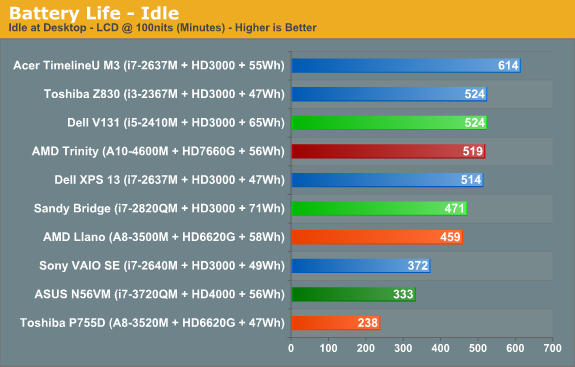
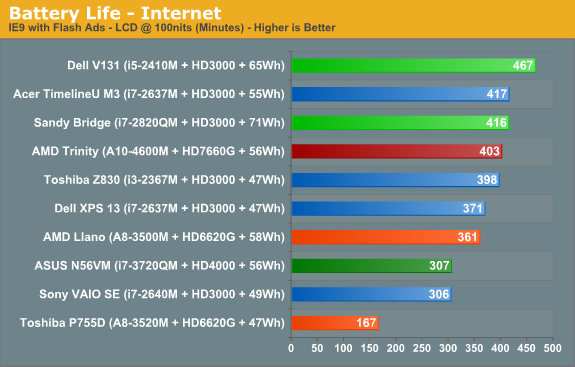
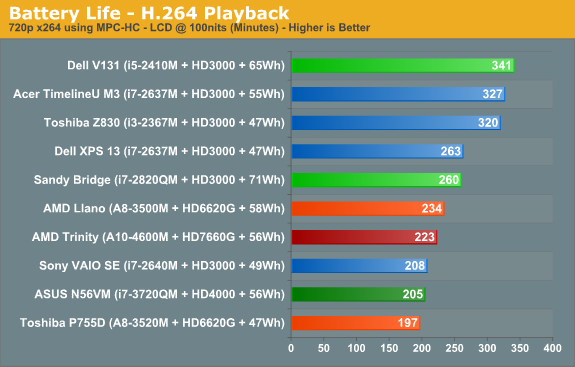
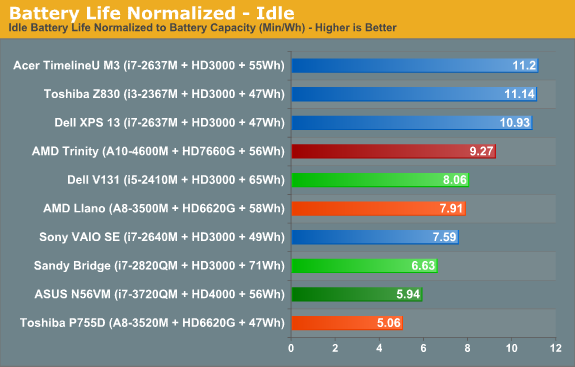

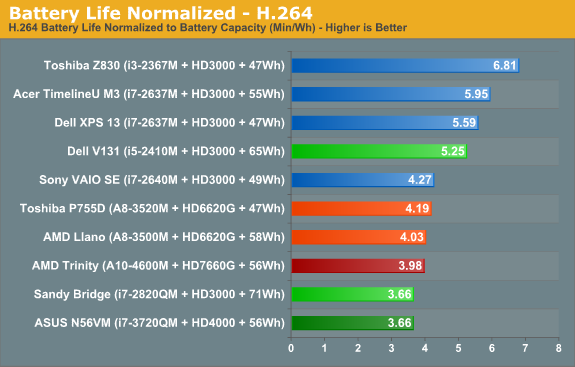
With a similar capacity battery to the original Llano laptop, and the same size 14” panel, Trinity comes out of the gates and posts two clear wins: idle battery life and Internet battery life are both up substantially relative to Llano. In fact, looking at the normalized charts, the only laptops that can consistently beat Trinity are found in Sandy Bridge ultrabooks—we won’t even bother discussing Atom or Brazos netbooks, as they’re competing in a completely different performance bracket. In something of a surprise, H.264 battery life doesn’t see the same benefit unfortunately, and it’s the one discipline where Llano still holds on to a slight lead over Trinity. Sandy Bridge meanwhile has always done very well in H.264 battery tests, and we see that with the Vostro V131 posting a normalized score that’s 30% better than Trinity and Llano. Of course, on the other end of the spectrum we have Ivy Bridge; we’ve only looked at one Ivy Bridge laptop so far, but if the pattern holds than Ivy Bridge will generally be a moderate step back in battery life relative to Sandy Bridge, giving AMD an even larger lead in this area.
We also performed a few other tests that we won’t present in graph form. One set of tests we alluded to earlier: the charts show Trinity with a Samsung 830 SSD, but we also ran tests with an Intel 520 SSD. Idle battery life dropped to 476 minutes (an 8% decrease), Internet battery life checked in at 371 minutes (down 8% again), and H.264 battery life stayed nearly the same at 217 minutes (down less than 3%). If battery life is one of your primary concerns, remember: all SSDs are not created equal!
Another test that we ran is simulated gaming; we looped the four graphics tests in 3DMark06 at 1366x768 until the battery ran out. We’ve run this same test on quite a few other laptops, and Llano initially looked to be far and away the best solution. Later, we discovered that when we tested Llano we were letting the GPU run in power saving mode—basically half the performance you’d get compared to being plugged in. We retested and measured 98 minutes, so the extra graphics performance comes with a heavy cost. We only tested Trinity (and Ivy Bridge and Sandy Bridge) using higher performance graphics settings, and this is one more area where it scores worse than Llano: Trinity managed just 77 minutes. That’s about the same as Ivy Bridge and Sandy Bridge (79 and 73 minutes, respectively), so if you’re after better gaming performance while running off the mains, you might need to keep looking.
Before getting too carried away with the above results, you still need to consider how important battery life is for your usage model. Some people travel a lot and like to go all day without plugging in; others will go from place to place and plug in whenever they’re not on the go. If you fall in the latter category, battery life isn’t usually a problem with any decent laptop, while those looking for all-day computing will definitely want as much mobility as possible. Ultimately, battery life is a factor of battery capacity as well as power optimizations done by the OEMs. We’ve seen battery life improve by as much as 50% when comparing two otherwise similar notebooks, but at least AMD’s reference platform for Trinity delivers a great starting point.
Temperatures and Acoustics
One other item we wanted to quickly touch on is system temperatures. We typically use HWMonitor and check temperatures of laptops under idle and load conditions. We did this with Trinity as well, but unfortunately the current version of HWMonitor doesn’t give us a lot of information. The only temperatures it reports are from the SSD and the HD 7660G graphics—there’s nothing about CPU core temperatures. That means we can’t provide much detail, other than to say that load temperature on the GPU topped out at 71C during extended testing, while the idle temperature was 39C. As usual, temperatures and noise levels go hand in hand, and the low 71C maximum GPU temperature matches up nicely with noise levels that never got above 37dB. It’s not the quietest laptop we’ve ever tested, and surface temperatures can get a little warm, but overall Trinity looks to be a good balance of performance and power requirements, which means quiet laptops are definitely possible.










271 Comments
View All Comments
meloz - Tuesday, May 15, 2012 - link
Quiet underwhleming. :\On the CPU side, IVB absolutely clobbers Trinity. People keep saying [FONT="Arial Narrow"]"CPU don't matter"[/FONT], but if you have a SSD the 'bottleneck' immediately shifts back to the CPU for certain tasks. It is always nice to have good single thread performance, and Intel enjoys a huge advantage in this area.
On the iGPU side, the much derided and seemingly impotent HD 4000 manages to actually narrow the lead AMD enjoyed on the graphics side. If only Intel drivers were written by people who had any clue, they would get even better performance out of their silicon.
So it will all come down to pricing. This is as much in Intel's hand as AMD's. AMD can potentially sell a lot of these things, but at a price where they won't be making any profits.
Congratulations to JW on another fine review, but a very underwhelming new product from AMD, as I said earlier.
jabber - Tuesday, May 15, 2012 - link
Trust me, no one applauds if I hold up my laptop and shout "BEHOLD THE WONDEROUS SINGLETHREADED PERFORMANCE! BASK IN IT'S POWER!!!"You are making too much of too little really.
meloz - Tuesday, May 15, 2012 - link
"You are making too much of too little really. "The marketshare and sales performance of the two rival products immediately proves you wrong. But keep digging the hole. Need a Bulldozer (or is it time for an Excavator) to speed up the processs?
jabber - Tuesday, May 15, 2012 - link
You're right, I'm obviously just not taking the issue as seriously as you are.Enjoy the endless benchmarking!
Ahem....
Taft12 - Tuesday, May 15, 2012 - link
AMD can't produce enough chips to meet demand and is improving marketshare every quarter. Their <1% quarterly increases are more like digging with a spoon, but it's digging in the right direction.medi01 - Thursday, May 17, 2012 - link
Market share means nothing, silly. Prescott had much bigger share than Athlon 64, while being inferior on all fronts.Spunjji - Wednesday, May 16, 2012 - link
Who's deriding the HD 4000? :/medi01 - Thursday, May 17, 2012 - link
If you have SSD bottleneck is your brain, that is too slow to distinguish between 22ms and 24ms.There is no way 20% faster version of an ALREADY SUCCESSFULL product is "underwhelming".
cjs150 - Tuesday, May 15, 2012 - link
Am aiming to start an HTPC build in the next couple of months. Mostly for movies but a little light gaming from time to time (Total War: Shogan on a 47" HD screen!)Low power of Trinity looked very promising...then I read Jarred's review.
Back to the i7-3770T even though the CPU+motherboard will be at least twice the price of the AMD versions.
Assimilator87 - Tuesday, May 15, 2012 - link
The desktop version of Trinity should fare better because of the TDP headroom, although it's extremely disappointing that it won't be released 'till Q3. I guess my mini-ITX case will have to sit in its box for another few months.